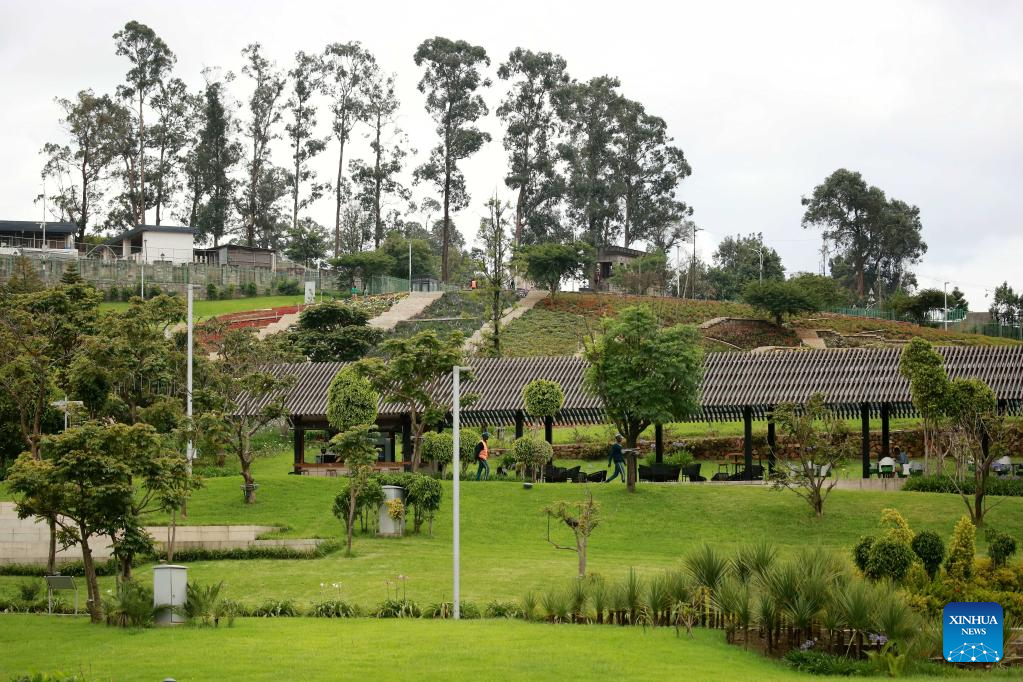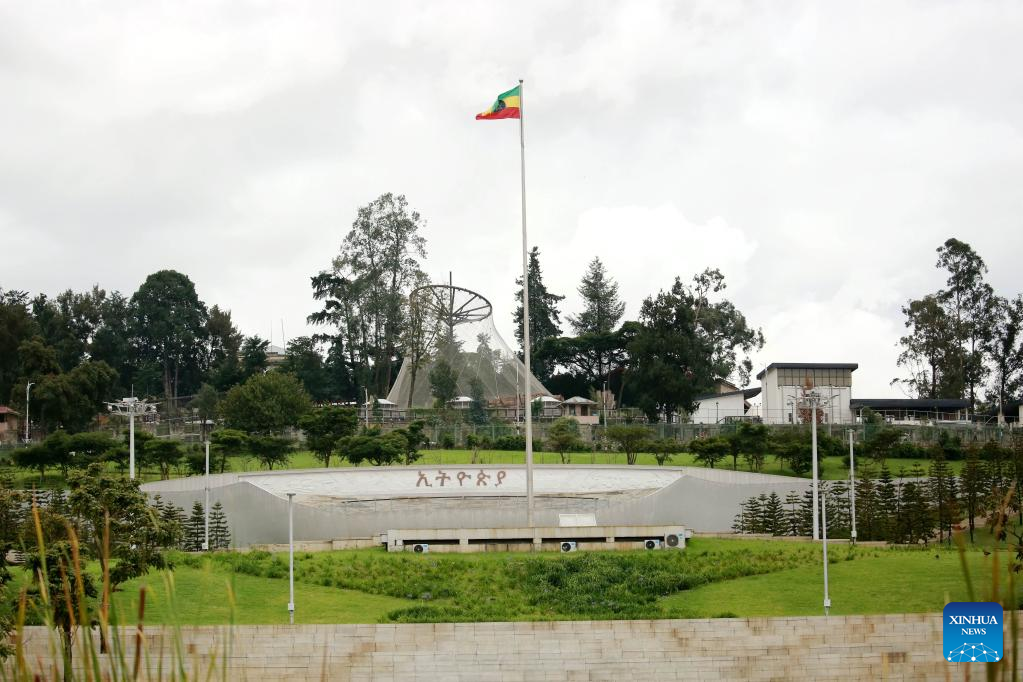
This photo taken on June 1, 2023 shows a view of Friendship Park in Addis Ababa, Ethiopia. (Xinhua/Wang Ping)
NAIROBI, June 10 (Xinhua) -- During the second session of the United Nations Habitat Assembly in the Kenyan capital here, "green buses" providing shuttle services to the delegates were eye-catching.
The buses were in keeping with the theme of the session that ran from June 5 to 9, "A sustainable urban future through inclusive and effective multilateralism: achieving the Sustainable Development Goals in times of global crises."
One of the firms offering the shuttle services is Kenya's startup BasiGo, which was the first company to launch electric buses in the country, using parts designed by Chinese automaker BYD.
"China is a global leader in electric mobility, inspiring African countries like Kenya in their quest for a dramatic shift to less carbon-intensive modes of transport," said Moses Nderitu, the chief revenue officer of BasiGo, adding that Chinese companies are open to sharing the latest technology with their partners.
China has, over the years, been sharing its experience in sustainable urban development in Africa and other developing regions, and contributing Chinese wisdom and solutions to improving the living environment of people in African countries.
GREEN MOBILITY
In January, the first phase of a China-built electric-powered light rail project in Nigeria's port city of Lagos was officially open for service.
Built by the China Civil Engineering Construction Corporation, the completed tracks of the Lagos Light Rail Mass Transit (LRMT) Blue Line project span 13 kilometers in the first phase and cover five stations.
As a symbolic project of the Belt and Road Initiative, the Blue Line project is the first electrified railroad and cross-sea light rail project in West Africa.
Babatunde Odejide, the railway project engineer at Lagos Metropolitan Area Transport Authority, said the Blue Line project is a great masterpiece.
"A distance that used to take 90 minutes to commute now is covered in 20, which is really convenient. Also, the Blue Line is electrically powered, an upgrade to clean energy, thus reducing harmful emissions such as exhaust fumes. I am glad to witness this. It makes our city more vibrant," Odejide said.
Former Nigerian President Muhammadu Buhari described the project as "historic," noting that it will reduce traffic congestion and air pollution, as well as improve the lives of locals.
Many African countries are currently experiencing a rapid wave of urbanization and thus plagued by "urban diseases" such as traffic congestion and air pollution.
With the upgrading of African public transport systems, low-carbon travel has gradually become the first choice of the local people.
In Kenya, the Chinese-built Nairobi Expressway has helped reduce carbon emissions by cutting travel time from the south to the west of the capital from two hours during peak time to 20 minutes.
Some 50,000 vehicles use the 27-km road daily, and as of April this year, over 12.5 million vehicles had traveled on it since its launch in July last year, said Steve Zhao, CEO of Moja Expressway Company which manages the modern thoroughfare.
GREEN ENERGY
In Zambia, President Hakainde Hichilema commissioned a Chinese-built hydropower plant in March, following the switching on of the plant's fifth generator.
The five generators at the Kafue Gorge Lower Hydropower Station, constructed by the Chinese firm Sinohydro Corporation Ltd., have added 750 megawatts to the country's national grid.
Hichilema said the completion of the project is not only good for the country's energy sector but also for the economy as a whole, as energy is a critical driver of the nation.
Fidelity Sindolo, who owns a salon in the Zambian capital of Lusaka, said the power supply has improved since the hydropower station started to generate electricity, enabling her to serve more customers.
"Thanks to improved power supplies, seven or eight new shops have opened on this street this year, including bars, supermarkets, and vegetable stalls," Sindolo said.
Africa is grappling with the effects of climate change. Therefore, developing green energy is an inevitable choice for the continent to achieve sustainable development.
Although Africa is rich in renewable energy resources such as hydro, solar and wind power, their exploitation is currently low.
China is helping Africa tap the resources. For instance, in De Aar, a town in the Northern Cape province of South Africa, Chinese company Longyuan Power has partnered with local firms to establish a wind power project that has been in operation since 2017, with an installed capacity of nearly 245 megawatts.
In Kenya, official figures showed that the installed capacity of solar power is more than 100 megawatts while the China-financed Garissa Solar Power Station accounts for 50 megawatts. Located in northern Kenya's Garissa County, it is the largest grid-connected solar power plant in East and Central Africa.
Costantinos Berhutesfa Costantinos, a professor of public policy at Addis Ababa University in Ethiopia, said multilateralism sets the tone for China's support for Africa in developing clean energy sources. "China has helped Ethiopia and other African countries with the process of low carbon green transformation," the professor said.
GREEN ENVIRONMENT
In just 11 months, a Chinese company has transformed a wasteland in Ethiopia into a green park that now hosts one of the most functional and largest urban comprehensive plazas in Africa.
Dubbed the Friendship Park, it is an important part of the first phase of the China-aided Addis Ababa riverside green development project.
The project integrates landscape, architecture, municipal administration, roads, water conservancy and a garden, and is undertaken by China First Highway Engineering Co., Ltd. (CFHEC).
Wei Qiangyu, the general manager at CFHEC Ethiopia office, said the riverside green development project introduces the Chinese concept of "lucid waters and lush mountains are invaluable assets" into Ethiopia, gaining popularity by managing the urban environment, and developing tourism to drive the economy, thus embarking on a path of green and sustainable development.
In Equatorial Guinea, the Malabo Urban Sewage Treatment Project is the largest municipal engineering project invested by the government and constructed by China Gezhouba Group Company.
Since the completion of the project in 2018, the quality of the effluent from the water plant has reached the discharge standard.
"Before the sewage treatment project was built, dirty water was everywhere. Now our drinking water is not polluted and is safe to drink. We have a lot fewer cases of typhoid fever, malaria and other diseases," said Celestino Ncogo Ndong Oyana, a resident of Malabo, the capital city.
Maimunah Mohd Sharif, executive director of the United Nations Human Settlements Programme, said China has been a pacesetter in urban regeneration in the recent past, inspiring the Global South, where cities are growing rapidly, to follow.
Sharif hoped that Beijing would continue facilitating the flow of technology and know-how to Africa's city planners, engineers and local investors to promote sustainable urban development on the continent.

This photo taken on June 1, 2023 shows a view of Friendship Park in Addis Ababa, Ethiopia. (Xinhua/Wang Ping)

This photo taken on June 1, 2023 shows a view of Friendship Park in Addis Ababa, Ethiopia. (Xinhua/Wang Ping)




 A single purchase
A single purchase









